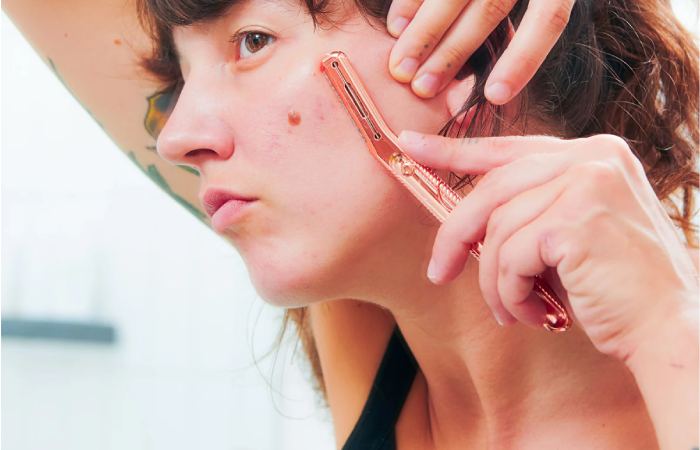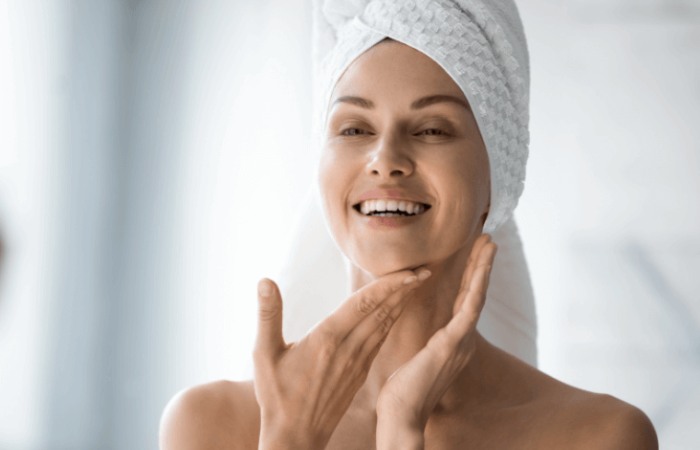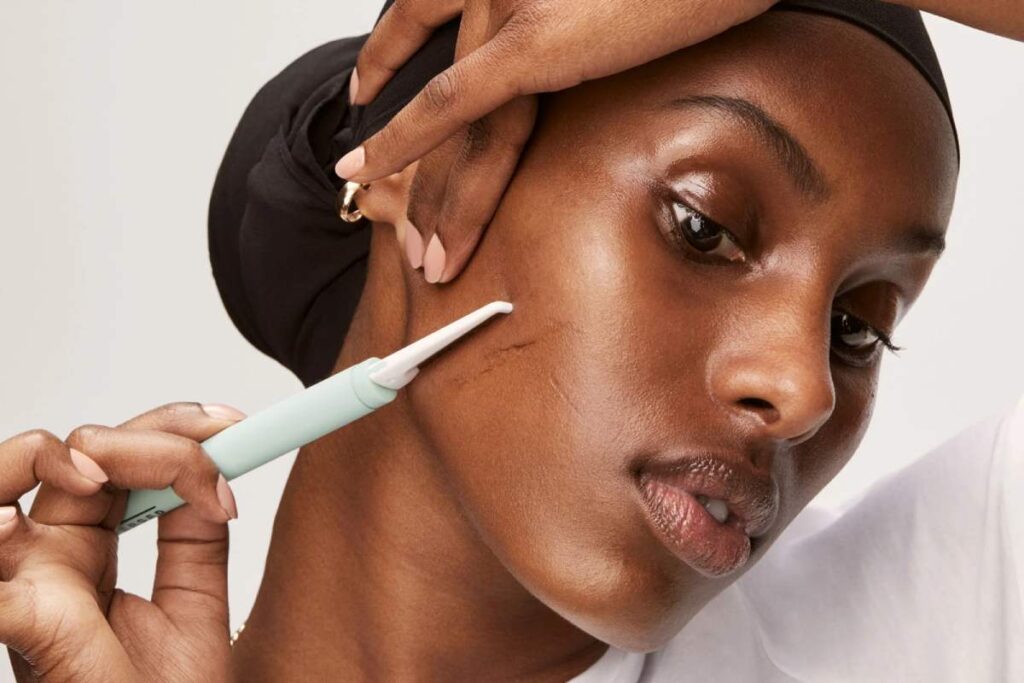Some swear by the silky results of dermaplaning, but is this viral skincare trend effective and safe? Absolutely, if you consult a spa professional for your treatment. Read on to learn some misconceptions about dermaplaning, not-so-ideal results, and our best tips for avoiding dermaplaning doubts.
What Is Dermaplaning?

Also identified as “microplaning” or “blading,” dermablading is a professional skin care treatment that scrubs the face with an exfoliating blade specially created for use on the skin. The process removes dead skin, product buildup, and hair (also known as peach fuzz) from the cheeks and chin. Then, you should notice and feel the rejuvenated and smooth skin on your face.
Tamara Hughes, regional sales and education representative for Eminence Organics, says confusing dermaplaning with shaving is a common mistake. “Dermaplaning and home shaving are completely different, and they use dissimilar tools to achieve different goals,” she says. “Though they both use a blade that moves across the skin, that’s all they have in common.”
“Despite the number of blades available at home,” says Hughes, “dermaplaning should always be performed by a certified dermaplaning technician.”
How To Avoid Dermaplaning Regret

You may be wondering if dermaplaning is “bad” for your skin. According to Healthline.com, dermaplaning can:
- Minimizes the appearance of acne scars, marks, and fine lines.
- Gives you a smooth and radiant complexion after treatment.
- It allows you to apply and remove makeup more easily because its surface is smoother.
Even skincare crops can be applied more easily, and some believe that the product penetrates the skin better.
Unlike laser hair removal and other beautifying treatments, there is little to no recovery time other than creation. Be sure you apply sunscreen and monitor your sun exposure time. Since dermaplaning only affects the top layers of the skin, it is considered a minimally invasive treatment that carries fewer risks than other treatments.
According to Hughes, freshly peeled skin may be perfect for improving the results of chemical peel treatments, facials, and microneedling.
Is it safe to do dermaplaning at home? No! Always go to a spa for this treatment, and do not try to do it at home. As for the results, they last approximately three weeks, and the skin, being fragile, runs the risk of being bare due to the harmful effects of the sun in the following days. Due to the fragility of the skin, avoid using retinol or tingling skin care products for a few weeks after treatment. People with certain skin conditions (see below) should not attempt dermaplaning actions.
Why Dermaplaning Should Only Be Done By An Esthetician
Rendering to Hughes, dermaplaning is usually performed by a certified technician. Dermaplaning is a professional treatment that removes dead skin cells and hair for two to three weeks. She explains the difference amid professional dermaplaning and using a razor at home: “During the treatment, they use a medical blade at a 45-degree angle with the primary goal of exfoliating. In comparison, facial shavers are tools with a guard that sits on the skin at a 35-degree angle and are designed to be used at home. Its main persistence is hair removal, and ONLY hair is removed from the surface of the skin.
Who Benefits From Dermaplaning?

All skin types can respond well to dermaplaning, and the practice may be particularly beneficial for those who:
- Acne scars and pustule marks
- Dull skin
- Dry Skin
- Sun damaged skin
- Fine wrinkles
Concerns about your hair which may thicken naturally due to age or circumstances such as polycystic ovaries.
Who Should Avoid Dermaplaning?
Rendering to WebMD and Healthline.com, you should avoid dermaplaning if you recently or regularly have:
- Severe sunburn
- Active outbreaks
- Sensitive skin
- Application of Accutane or tretinoin in the last six months.
- Cancer and are undergoing treatment for cancer.
- Keloids
- Eczema
- Rosacea
- spider veins
- cystic acne
- Hirsutism
- Viruses such as chickenpox or grits.
Common Dermaplaning Regrets
1: You “Wing It” And Try It At Home
It’s not difficult to find a dermaplaning blade at home, but just because you can try a dermaplaning facial doesn’t mean you should.
“A certified dermaplaning technician should always perform dermaplaning to avoid injury and adverse reactions,” says Hughes. “You should be sure to look for certified technicians who have been skilled in the proper techniques. Be sure to read reviews and discuss the treatment with them before you begin.”
Without proper training, disinfection knowledge, or the tilt angle of the tool, you risk damaging the delicate skin on your face, which can lead to infections, irritation, scratches, or even scars.
YouTuber Natalies Outlet references her own bad experience after dermaplaning with an old blade and describes the results as “ingrown hairs.” “I had lumps for months,” she says in her video.
2: Your Breakouts Worsen
According to the Cleveland Clinic, the gliding motion of dermaplaning can make escapes worse by spreading bacteria. Over time, it can even cause more breakouts and worsen existing acne. We always recommend avoiding dermaplaning if you have active acne breakouts or using acne treatments such as Accutane or Isotretinoin. However, if you think your skin is light enough to try this practice, be sure to work with a professional to keep dermaplaning tools away from any broken skin or blemishes.
3: Dermaplaning Irritates Your Skin
Although you may be impressed with an initial smooth feeling, a few hours later, your skin may feel tight and irritated if dermaplaning has been working a little longer than your sensitive skin would like. We always recommend speaking to your dermaplaning professional or dermatologist before treatment to find out if it is right for you.
However, if your skin only experiences sensitivity occasionally, consider an oil planning action that applies a layer of facemask oil to the skin before dermaplaning to reduce friction. Always remember that your treatment must be slow, cautious, and very light on the skin to avoid cuts and annoyance.
4: Revive an old cold sore
Inappropriately, in the wrong place, it can reactivate an old cold sore, thereby reactivating the herpes simplex virus in the skin. To avoid this, see a doctor to prescribe oral anti-herpes medications or an antibiotic to prevent any outbreaks, and always tell your dermatologist about your history of cold sores before your treatment.
5: Neglecting Your Skin After Treatment
Because it removes a layer of old skin to expose new skin, a vital routine is necessary in the weeks following treatment. According to SELF.com, it takes about 14 days for epidermis cells to renew themselves, so follow your facial with a routine that refills the skin barrier to maintain smooth, healthy skin in the long term.
This means focusing on:
- Moisturizing serums and hyaluronic acids to hydrate the skin.
- Hydration in the weeks following treatment.
- Sunscreen because your skin is even more susceptible to UV damage.
- Avoid skin care products that make you tingle.
- Avoid retinol
- Gentle cleaning
With proper care and expert help, dermaplaning rejuvenates the skin and leaves it perfectly smooth. If you would like to experience this innovative treatment, visit our spa radar and call your nearest Eminence Organics partner spa to see if they offer dermaplaning services.


